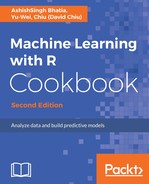The support vector machine constructs a hyperplane (or set of hyperplanes) that maximize the margin width between two classes in a high dimensional space. In these, the cases that define the hyperplane are support vectors, as shown in the following figure:

The support vector machine starts by constructing a hyperplane that maximizes the margin width. Then, it extends the definition to a nonlinear separable problem. Lastly, it maps the data to a high dimensional space where the data can be more easily separated with a linear boundary.
The advantage of using SVM is that it builds a highly accurate model through an engineering problem-oriented kernel. Also, it makes use of the regularization term to avoid over-fitting. It also does not suffer from local optimal and multicollinearity. The main limitation of SVM is its speed and size in the training and testing time. Therefore, it is not suitable or efficient enough to construct classification models for data that is large in size. Also, since it is hard to interpret SVM, how does the determination of the kernel take place? Regularization is another problem that we need tackle.
In this recipe, we continue to use the telecom churn dataset as our example data source. We begin training a support vector machine using libsvm provided in the e1071 package. Within the training function, svm, one can specify the kernel function, cost, and the gamma function. For the kernel argument, the default value is radial, and one can specify the kernel to a linear, polynomial, radial basis, and sigmoid. As for the gamma argument, the default value is equal to (1/data dimension), and it controls the shape of the separating hyperplane. Increasing the gamma argument usually increases the number of support vectors.
As for the cost, the default value is set to 1, which indicates that the regularization term is constant and the larger the value, the smaller the margin is. We will discuss more on how the cost can affect the SVM classifier in the next recipe. Once the support vector machine is built, the summary function can be used to obtain information, such as calls, parameters, number of classes, and the types of label.
